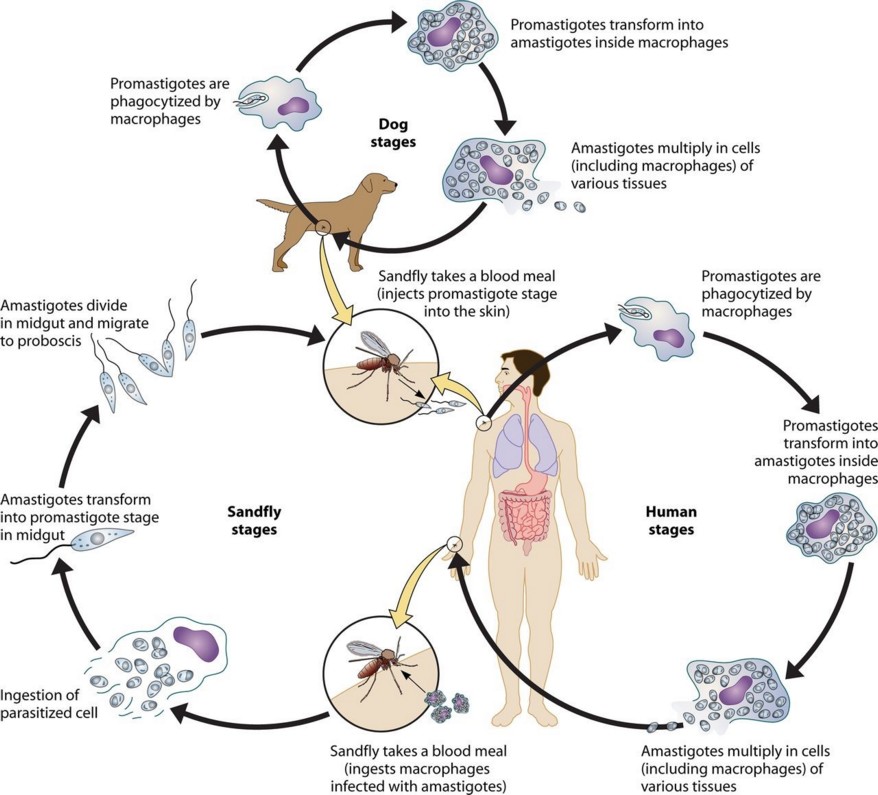Group of parasitoses caused by a protozoan of the genus 'leishmania' that infects the human host macrophages and is transmitted by a small diptera ("sand fly"), the sandfly.
Leishmania: flagellate protozoan, of which there are different subspecies. Lives in form promastigote in the gut of the sandfly and amastigote intracellular form in the vertebrate host (rodents, stray dogs, man). Virulence varies from one subspecies to another.
Sandfly: small diptera of 2-3 mm; it is the female which is bloodsucker; especially bites during the night
There may be a person-to-person transmission (without the sandfly bite) by puncture or crushing of the sandfly.
Endemic areas: Southern Europe, East Africa, South Asia, South America, more recently Tunisia, Morocco, Algeria. The incidence is increasing in the world. The visceral form of adulthood increases because of the association with HIV. Emerging disease among travellers.

- visceral leishmaniasis or Kala-azar : uncommon in adults except in case of diminished immunological defences (more frequent association with HIV infection). Affects especially the child of 1 to 3 years of age; due to L infantum (Mediterranean, Middle East, Brazil) or L donovani (India, Sudan)
Incubation: 3 to 6 months
Invasion: in 2-3 weeks, irregular fever
State phase: major splenomegaly, hepatomegaly, anemia, fever, weight loss
Evolution: without treatment, death within a few months.
- cutaneous leishmaniasis (Aleppo button, East button): polymorphic injury, slow, painless, without general signs
Incubation: long, 1 to 3 months
Invasion: at the site of the bite, painless, non-pruritic indurated papule
State phase: may be,
- localized: ulcerated or ulcero-crusted lesion: spontaneous healing in 3-6 months with indelible scar;
Europe du Sud-Africa-Asia: L. major L, l. infantum, sometimes L tropica (form where there is only a human tank)
South America: L guyanensis (causes yaws), L amazonensis, L braziliensis, L mexicana (chicleros' ulcer)

- diffuse: form nodular, non-ulcerated, pseudo-lepromatous due to L aethiopica in East Africa
- associated with HIV: clinical polymorphism: diffuse, pseudo-lepromatous, slicks, ulcerated
- mucocutaneous leishmaniasis: especially in South America, caused by L braziliensis (Espundia). After skin injury, metastatic lesions at the level of the mucous membranes of the ENT zone (nasal septum perforation, breach larynx).
Treatments:
- pentavalent antimony derivatives (IM)
- salts of pentamidine: renal or hematological risk, diabetes
- amphotericin B: risk of renal toxicity
- miltefosine (by mouth)
Anesthetic implications:
side effects of the treatment; precautions against accidents by sting
References :
- Ezzouine H, Charra B, Benslama A, Motaouakkil S.
Sepsis sévère révélant une leishmaniose viscérale chez un adulte immunocompétent.
Ann Fr Anesth Réanim 2010 ; 29 : 255-6.
- Vila-Payeras A, Llambrich-Manes A, Nadal Llado C.
Erythematous nodule with central crust on the nail fold of an infant.
JAMA Dermatology 2020
Updated: August 2020